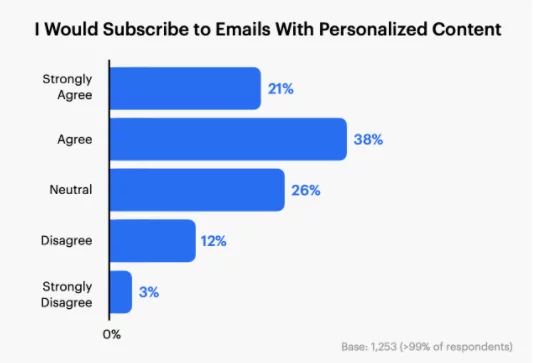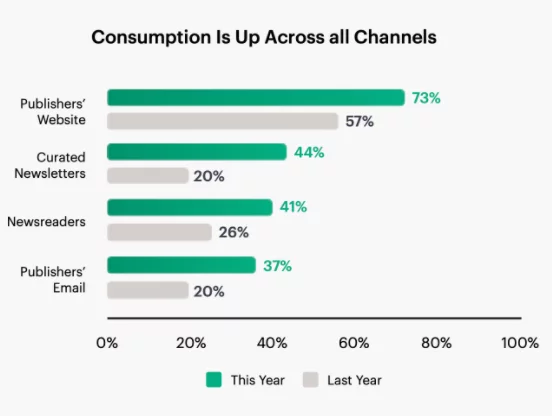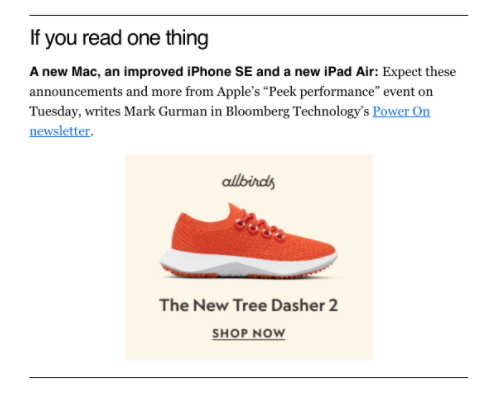If you think of personalization as a target, a bullseye is the sweet spot: when you reach the right audience in the right place at the right time with the right content.
…right?
For publishers, hitting this bullseye isn’t just a nice win every once in a while. It’s actually a necessity if you want to cut through the noise and grab your audience’s attention with compelling content.

According to Jeeng’s 2022 a Digital Publishing Consumer Survey Report, personalization is essential to driving engagement and revenue. In fact, customers are demanding it.
As our research found, two-thirds of U.S. audiences would be more likely to subscribe to publishers’ emails if they know the content will be personalized to their interests. And more than half say they want emails that are personalized to their behavior, interests, location, or birthday.

We’ve also reached a new tentpole in the history of email marketing. With third-party cookies going away, publishers are being challenged to rework the way they approach targeting and personalization. That means unraveling decades of traditional approaches and adopting entirely new tools and strategies to future-proof their businesses.
So, how can publishers deliver those personalized experiences and hit that bullseye every time? By targeting the right audience segments with relevant content that matches their current needs and preferences.
Here’s what you need to know.
Why are personalized experiences important?
Personalized customer experiences are more important than ever as digital consumption increases across channels. According to our study, 66% of Americans say they watched or read more this year than they did last year. Specifically, people are turning to publishers’ websites, email newsletters, and news reader apps for information.

Speaking of email newsletters, publishers have seen a 2X increase in readership on that channel and more than 3 out of 4 consumers say they check email several times a day — up from 2 out of 3 last year. Add to that, half of U.S. adults want website content from publishers to be personalized to their interests — up from 44% last year.
This desire for personalized engagement also translates to revenue for publishers. Because, among those who pay for a subscription to a digital publication or email, 42% do so because they want the content to be personalized to their interests.
Millennials, in particular, are more likely than other generations to desire personalized emails. And over half of millennials and Gen Z pay for publishers’ subscriptions because they want the content to be personalized.
If publishers don’t continuously personalize their content, on the other hand, they risk frustrating audiences and collecting “Dear John” breakup letters as people unsubscribe from their offerings.
How can you target audiences with relevant content?
The first step to targeting audiences with personalized content is gathering data to understand their specific interests, preferences, and behaviors.
That means building a first-party data strategy and collecting information directly from your customers. Email, for example, is one of the most valuable pieces of first-party data in digital marketing. People use it to get one-on-one communications in their inboxes, sign into sites across the web, make e-commerce purchases, and create memberships and accounts.

Once you have your first-party data, you can begin to build target audience profiles and unique audience segments. For instance, you might group consumers according to different factors like age, gender, location, job, content preferences, device type, and online behaviors.
From here, you can build personalized content that speaks to the wants and needs of each group, helping your publication increase engagement and drive revenue. You can then target each customer segment using an automated marketing personalization engine or platform.
With Jeeng’s algorithm, for instance, publishers can target their customer bases by:
- Platform (desktop vs. mobile)
- Device type (Android vs. iOS)
- State
- Age and gender
How does personalization impact monetization?
Personalization and targeting aren’t just important for reaching customers with relevant organic content. They can also help supercharge your monetization strategy, increasing conversion rates and profits.
Think about it. If you can offer ad partners an opportunity to get in front of built-in, segmented audiences, you can drive more revenue directly from your email newsletters and website content. So a sports advertiser, for example, can deliver their ads alongside different content than a fashion or home goods advertiser.
As our study found, 69% of U.S. consumers say they will click on an ad in an email newsletter if it’s interesting or relevant to them. Millennials, again, are more likely than other generations to respond to these ads.
Just look at this display ad within a newsletter from Bloomberg. It targets people who’ve already engaged with Allbirds content at the moment they’re consuming something new. From here, they can choose to click on the ad and research the brand further or simply continue reading their newsletter.

How Jeeng can help with targeting and personalization?
Done right, targeting and personalization have to incorporate real-time data into cross-channel outreach strategies that engage just the right audiences.
And Jeeng has the tools to make it happen.
With just one line of code on your website, our proprietary algorithm will automatically gather data, curate segments, and distribute content that your readers want to see. So you can give subscribers the royal treatment they deserve while generating clicks and revenue for your publication.
In other words: bullseye.
Ready to win over your audiences with personalized messaging? Contact us to get started.


